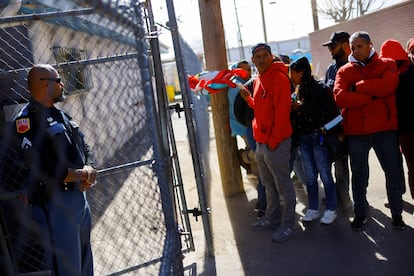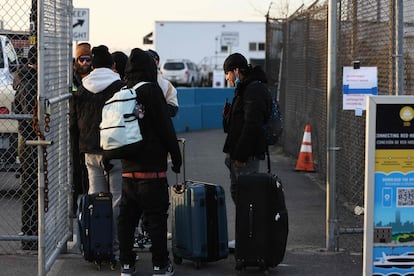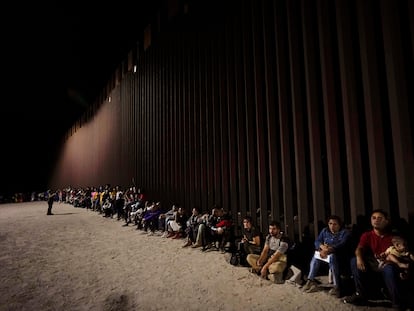For Latin American migrants in New York, arduous journey is a road to nowhere
The city has been struggling to accommodate 45,000 new arrivals. Mayor Eric Adams – who insists that there is no more room – is asking them to go to Canada


Manuel, a 24-year-old Venezuelan citizen, has gone through countless hurdles over the last four months in New York City. He has found this to be more exhausting than everything else he has experienced since he left Caracas, including crossing the Darién Gap between Colombia and Panama, waiting anxiously at the US southern border, or being held in an overcrowded detention center in Laredo, Texas.
Since he arrived in the Big Apple – on a bus chartered by Texas Governor Gregg Abbott, of the Republican Party – Manuel has stayed in a tent camp set up on Randall’s Island (north of Manhattan) and at a three-star hotel in Midtown. Today, he sleeps inside a compound at the cruise terminal in Brooklyn, where a thousand cots are lined up like sardines in a can. The site hosts male migrants who are travelling alone, providing accommodation for up to a week.
The conditions these migrants live in illustrate the difficulty the New York authorities have had in managing the arrival of over 45,000 of them since last spring. Most of them, like Manuel, are asylum seekers. Several were transferred to Manhattan via bus – oftentimes without knowing their final destination – by Republican governors in Texas and Florida, who are attempting to denounce the immigration policy of the Biden administration.
So far, the Mayor’s Office seems powerless to deal with the influx. The shelter network has reached capacity due to New York City’s large floating population of homeless people. In recent days, the municipal authorities have been offering migrants free bus tickets to Canada.
As the months go by, the journey that these people once undertook from their countries of origin is turning into a trip to nowhere, with their lives becoming increasingly precarious.
Dragging along a gigantic pink suitcase – his only luggage – Manuel (a pseudonym) doesn’t know whether he should accept a free ticket. His initial attempt to land in another state (where he has a friend) didn’t work out. He shrugs with a trained sense of resignation – the same sensation that he felt when he had to leave the hotel in Midtown, which now only houses families for a period of 10 days. One such family is made up of Javier, a former sergeant in the Venezuelan Army who deserted, his wife, Nazaret, and their two children. The youngest is in a stroller; the oldest was enrolled in school only three days after their arrival.
Manuel, who says that he can “work any job,” accepts his circumstances. “It is what it is… we can’t forget to be grateful,” he says, alluding to a riot that other migrants in difficult situations staged at the hotel entrance, dissatisfied with being sent off.
Carlos Herrera, a 44-year-old Ecuadorian who emigrated “to earn money and pay off some debts,” never thought that he would reach New York. He spent several nights sleeping outside the entrance of the hotel in Midtown to protest his forcible transfer. “I just started working as a plumber in a neighborhood that’s at the other end [of the city]... but I’ll lose my job because there’s no subway [connection].”
The police finally subdued the protestors. Mayor Eric Adams – a Democrat with a flair for the dramatic – subsequently spent the coldest night of winter last week on a cot in the Brooklyn terminal with the new tenants, who currently number around 500.

“There is no space”
NGOs and volunteers have been filling gaps in the response but the constant influx of migrants is derailing any plan to formalize aid. “New York is on the edge, it’s about to break,” repeats Adams, whose rhetoric is taking on a tone increasingly similar to that of the Republican governors in Texas and Florida. This past January, he used similar words when he made a visit to the border city of El Paso, Texas.
From New York as a “safe harbor” – open to all – to “there is no space” to a “national crisis” that deserves a stronger response from Washington, the language is quickly shifting.
The migratory pressure is testing the identity of the city. It’s also causing a lot of pain: one only has to look to the attempted suicide of a 26-year-old man in the Brooklyn terminal on Thursday, February 16.
The host organizations have denounced the conditions of the makeshift space – the fifth of these locations to be set up since the crisis began – which is deprived of any means of public transport and sits, isolated, on the edge of the water.
“It’s in a high-risk flood area and will unnecessarily expose residents [to the elements] during some of the coldest months of the year,” the Legal Aid Society and the Coalition for the Homeless said in a joint response. “Hotels have always been the best short-term options, in contrast to setting up tents in inaccessible areas of the city prone to flooding.” This statement was in reference to shelters such as the Brooklyn terminal and, before that, the camp at Randall’s Island.
The Brooklyn site is a collective dormitory “without space or privacy… a place that [results in] insecurity and indignity,” the two organizations added. “The failings we warned about weeks ago are still in force, the first of which is disregarding the individual needs of migrants.”
Herrera had long anticipated this scenario: “Here, in the hotel, I had my single room, with a TV. I don’t want television, I don’t need it – but I do want a place to rest alone when I return from work. I don’t [want to] suffer from other people’s parties, [when they] drink and sing until dawn,” he explains, justifying his determination to be allowed to stay on at the hotel in Midtown. The protest – which saw Herrera wrapped in a blanket at the door of the hotel, alongside several dozen migrants – lasted a few hours, until a peaceful eviction by police took place.
This migration crisis, which is mostly made up of Venezuelans, is divided into both single men – who are either economic or political migrants – and families, who, with a bit of luck, will find accommodation in the city and a school for their children. But the challenge for the authorities is huge. Mayor Adams is demanding federal assistance to the tune of $1 billion.
“We continue to surpass both our moral and legal obligations and meet the needs of people arriving in New York, but as the number of asylum seekers continues to grow, we are in serious need of support from both our state and federal governments,” he said at the end of January.
Javier and Nazaret – who spend their days pushing their daughter’s stroller through the streets until the cold brings them back to the hotel – lament the bad food (“the baby only gets milk”) and the lack of clothing (“they send us to charities, they don’t have anything here”).
“I’m looking for work in whatever [sector]... construction, hospitality: we cannot return to Venezuela if things don’t change. It was impossible to survive there. There are strikes and protests every day. But here, freedom is very expensive – we don’t have anything to support ourselves with,” explains Javier, who tells EL PAÍS that he and his wife have not received any assistance to process their asylum claims.
Manuel contradicts him: “As soon as you cross the [US] border, in the detention center they take you to, they subject you to a ‘credible fear’ screening, to determine whether the reasons you give to request asylum are true. That’s where the procedures begin.”
Manuel displays a crumpled piece of paper that he was given in downtown Laredo – his only guide to making his way in New York. Or in Canada, “because they’ve told me that getting papers and a work permit is easier there.”
For now, the pilgrimage being made by thousands has already marked a new destination: the Roxham Road border crossing, through which more than 39,000 migrants crossed into Canada last year. In December of 2022 alone, 4,600 passed through. As the procedures have been handled diligently – and as the Canadian government aims to welcome 465,000 new permanent residents in 2023 – the overwhelmed authorities in New York City see their northern neighbor as the only option to defuse the crisis at hand.
Sign up for our weekly newsletter to get more English-language news coverage from EL PAÍS USA Edition
Tu suscripción se está usando en otro dispositivo
¿Quieres añadir otro usuario a tu suscripción?
Si continúas leyendo en este dispositivo, no se podrá leer en el otro.
FlechaTu suscripción se está usando en otro dispositivo y solo puedes acceder a EL PAÍS desde un dispositivo a la vez.
Si quieres compartir tu cuenta, cambia tu suscripción a la modalidad Premium, así podrás añadir otro usuario. Cada uno accederá con su propia cuenta de email, lo que os permitirá personalizar vuestra experiencia en EL PAÍS.
¿Tienes una suscripción de empresa? Accede aquí para contratar más cuentas.
En el caso de no saber quién está usando tu cuenta, te recomendamos cambiar tu contraseña aquí.
Si decides continuar compartiendo tu cuenta, este mensaje se mostrará en tu dispositivo y en el de la otra persona que está usando tu cuenta de forma indefinida, afectando a tu experiencia de lectura. Puedes consultar aquí los términos y condiciones de la suscripción digital.
More information
Archived In
Últimas noticias
What is known about the Interoceanic Train derailment in Oaxaca
Trump turns a Minnesota fraud allegation into ammunition for his MAGA army against Democrats
The year Trump created 1.6 million undocumented immigrants
Russia threatens to break off negotiations after accusing Ukraine of attacking one of Putin’s residences
Most viewed
- Reinhard Genzel, Nobel laureate in physics: ‘One-minute videos will never give you the truth’
- Oona Chaplin: ‘I told James Cameron that I was living in a treehouse and starting a permaculture project with a friend’
- Pablo Escobar’s hippos: A serious environmental problem, 40 years on
- Chevy Chase, the beloved comedian who was a monster off camera: ‘Not everyone hated him, just the people who’ve worked with him’
- Why we lost the habit of sleeping in two segments and how that changed our sense of time










































